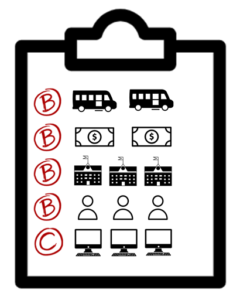Don’t let these five organizational areas derail your district’s mission!
The pandemic has only exacerbated the problems that many school districts across the U.S. are facing. I had a wise mentor who once told me, “The things you go to school for are not the things that are going to get you fired, because the things that are going to get you fired are the 4 B’s – buses, budgets, buildings, and bureaucracy.” Those things probably resonate with a lot of district leaders because that’s what causes most of their headaches and where many of the day-to-day complaints reside.
When you layer in the added concern of cybersecurity, I would tell someone in the field today to pay attention to the 4 B’s and a C (for cyber). Any one of these areas, if mismanaged, can derail a district from its real mission – student success.
Budget
In many districts, the budget cycle discussion begins with “What was our budget last year?,” not “How do we best meet the needs of those we serve?” When you examine many budgets, too often they do not reflect the “situation on the ground” or the stated vision, mission, and values of the district.
Too many districts are running at a deficit and don’t even know it. Their budgets balance on paper, but critical needs are not being met. School districts simply cannot spend money they do not have. So, when the money runs out, one of the first things to suffer is infrastructure and/or the replacement of critical assets, which includes buses, HVAC systems, or other operational necessities.
Budgets get out of control when districts appease the loudest voice in the room or most popular trend versus taking the time to plan and solve for the district holistically. Think of it as getting an oil change for your car. If you are short of funds, you can elect to skip the oil change for your car once, twice, maybe even three times. But at some point, if you don’t get an oil change, your engine may stop running. At that point, the relatively small immediate savings is obliterated by exponential budgetary impact. Don’t let your budget get out of control because you are putting off things until tomorrow that need to be addressed today.
Buses and Buildings
If we look at the infrastructure crisis inside school districts today, we know it didn’t happen overnight. It happened because the easiest way to balance your budget in a school district is to deprioritize maintenance and replacement line items. Similar to the oil change example, the problem districts experience is that they often defer these costs for so long that it doesn’t get readdressed until some piece of critical infrastructure has completely gone off the rails. So instead of paying a reasonable amount every year, you are now trying to find money to replace a complete system or fleet. This disparity can throw a district off course.
We see this in a lot of districts: the maintenance of critical systems (buses, school buildings, or their internal components and infrastructure) have been extremely neglected. Over time, they become big issues that can threaten the solvency of a district. Our team knows this can be a blind spot for many leaders, especially those transitioning into a new district. As part of our organizational effectiveness assessments, we check to see if the district’s budget is aligning its limited resources with its goals and assess if the district is spending money on those items that are operationally non-negotiables.
Bureaucracy
Many times, school districts’ organizational structures and services become institutional, meaning that they function because they have always functioned that way, not because they are focused on efficiency, effectiveness, or efficacy. The phrase “we have always done it that way” is a typical justification for ineffective processes and services.
We provide an objective third-party evaluation of a district’s organizational structure and internal culture. It’s important to check the alignment between departmental structure and staffing with overall district goals. We look to see if the district is organized effectively to accomplish both its goals and necessary functions.
Cyber
Just as the 4 B’s could undermine the goals of your school district, cyber has the potential to completely dismantle a district. Cyberattacks are one of the largest threats facing school districts today and may not be taken seriously enough. Having led one of the largest school district IT departments in the U.S., I know that we were under dozens of attacks each day as were other districts. That’s why MGT’s Technology team offers private-sector, enterprise-grade technology solutions to the public sector as an important component of an organizational assessment.
All these areas can be addressed with a comprehensive organizational review. This type of analysis will uncover the most effective ways to solve problems and create a path forward. The recommendations we provide, with district leadership collaboration, can provide a playbook on how to move forward to become a high-performing organization, which then supports the real work of a school district―helping students succeed in the classroom.
Organizational reviews are customizable because there isn’t a cookie- cutter approach. We partner with a district in evaluating the things that matter to their students, community, school board members, and superintendent. The value we bring is an honest appraisal of your district’s organizational health from an operations standpoint and an evaluation of your ability to deliver on the goals and aims of your district.
We will ask you the tough questions, like:
- Have you put your money on what you have prioritized?
- Do you make the necessary steps to protect and maintain your infrastructure so it is sustainable?
- Is your district right-sized and are those schools in the right places?
- Is your organizational structure hard to navigate?
- Does bureaucracy slow down any initiative?
We have led schools, managed school districts, and have been personally responsible for the areas we evaluate and the recommendations we make. We are education leaders supporting education leaders and have made many of the decisions you’re making. To lead with empathy means we’ve worked in hundreds of school districts across the country and bring an unparalleled expert view into your world to offer best practices and insights that have proven successful for other districts.
Starting with the 4 B’s and C will put rigor around the areas where many school leaders don’t have a high level of expertise. A well-organized school district dramatically increases opportunities for students to thrive. If you can streamline all five areas to make them as effective as possible, you improve the lives of children.


